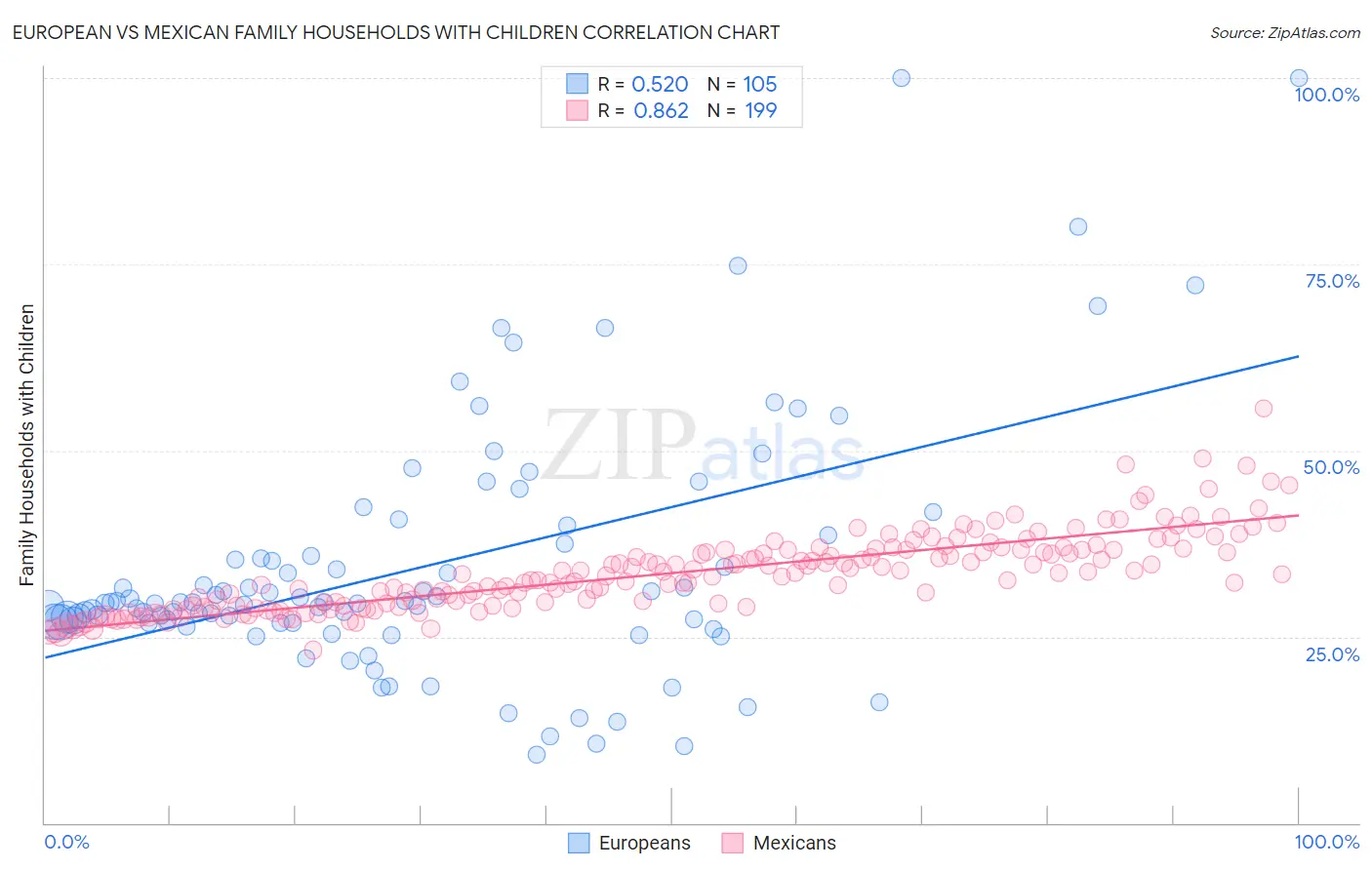European vs Mexican Family Households with Children
COMPARE
European
Mexican
Family Households with Children
Family Households with Children Comparison
Europeans
Mexicans
27.9%
FAMILY HOUSEHOLDS WITH CHILDREN
95.4/ 100
METRIC RATING
120th/ 347
METRIC RANK
31.4%
FAMILY HOUSEHOLDS WITH CHILDREN
100.0/ 100
METRIC RATING
4th/ 347
METRIC RANK
European vs Mexican Family Households with Children Correlation Chart
The statistical analysis conducted on geographies consisting of 560,876,859 people shows a substantial positive correlation between the proportion of Europeans and percentage of family households with children in the United States with a correlation coefficient (R) of 0.520 and weighted average of 27.9%. Similarly, the statistical analysis conducted on geographies consisting of 564,219,663 people shows a very strong positive correlation between the proportion of Mexicans and percentage of family households with children in the United States with a correlation coefficient (R) of 0.862 and weighted average of 31.4%, a difference of 12.4%.

Family Households with Children Correlation Summary
| Measurement | European | Mexican |
| Minimum | 9.1% | 23.2% |
| Maximum | 100.0% | 55.6% |
| Range | 90.9% | 32.5% |
| Mean | 34.4% | 33.5% |
| Median | 29.6% | 33.1% |
| Interquartile 25% (IQ1) | 26.9% | 29.1% |
| Interquartile 75% (IQ3) | 38.0% | 36.6% |
| Interquartile Range (IQR) | 11.2% | 7.6% |
| Standard Deviation (Sample) | 16.9% | 5.2% |
| Standard Deviation (Population) | 16.8% | 5.2% |
Similar Demographics by Family Households with Children
Demographics Similar to Europeans by Family Households with Children
In terms of family households with children, the demographic groups most similar to Europeans are Zimbabwean (27.9%, a difference of 0.030%), Immigrants from Malaysia (27.9%, a difference of 0.070%), Central American Indian (27.9%, a difference of 0.070%), Pakistani (27.9%, a difference of 0.080%), and Immigrants from Western Asia (27.9%, a difference of 0.19%).
| Demographics | Rating | Rank | Family Households with Children |
| Arabs | 97.0 /100 | #113 | Exceptional 28.0% |
| South American Indians | 96.9 /100 | #114 | Exceptional 28.0% |
| Immigrants | Africa | 96.8 /100 | #115 | Exceptional 28.0% |
| Pakistanis | 96.0 /100 | #116 | Exceptional 27.9% |
| Immigrants | Malaysia | 95.9 /100 | #117 | Exceptional 27.9% |
| Central American Indians | 95.9 /100 | #118 | Exceptional 27.9% |
| Zimbabweans | 95.6 /100 | #119 | Exceptional 27.9% |
| Europeans | 95.4 /100 | #120 | Exceptional 27.9% |
| Immigrants | Western Asia | 93.6 /100 | #121 | Exceptional 27.9% |
| Immigrants | Zimbabwe | 92.8 /100 | #122 | Exceptional 27.8% |
| Immigrants | Northern Africa | 91.8 /100 | #123 | Exceptional 27.8% |
| Immigrants | Singapore | 90.8 /100 | #124 | Exceptional 27.8% |
| Ecuadorians | 90.8 /100 | #125 | Exceptional 27.8% |
| Immigrants | Ethiopia | 90.5 /100 | #126 | Exceptional 27.8% |
| Belizeans | 90.0 /100 | #127 | Exceptional 27.8% |
Demographics Similar to Mexicans by Family Households with Children
In terms of family households with children, the demographic groups most similar to Mexicans are Tongan (31.2%, a difference of 0.41%), Immigrants from Mexico (31.6%, a difference of 0.78%), Immigrants from India (31.0%, a difference of 1.0%), Immigrants from Central America (31.0%, a difference of 1.3%), and Yakama (30.8%, a difference of 1.9%).
| Demographics | Rating | Rank | Family Households with Children |
| Yup'ik | 100 /100 | #1 | Exceptional 37.0% |
| Inupiat | 100 /100 | #2 | Exceptional 32.8% |
| Immigrants | Mexico | 100.0 /100 | #3 | Exceptional 31.6% |
| Mexicans | 100.0 /100 | #4 | Exceptional 31.4% |
| Tongans | 100.0 /100 | #5 | Exceptional 31.2% |
| Immigrants | India | 100.0 /100 | #6 | Exceptional 31.0% |
| Immigrants | Central America | 100.0 /100 | #7 | Exceptional 31.0% |
| Yakama | 100.0 /100 | #8 | Exceptional 30.8% |
| Thais | 100.0 /100 | #9 | Exceptional 30.6% |
| Immigrants | Fiji | 100.0 /100 | #10 | Exceptional 30.5% |
| Nepalese | 100.0 /100 | #11 | Exceptional 30.5% |
| Immigrants | Pakistan | 100.0 /100 | #12 | Exceptional 30.2% |
| Afghans | 100.0 /100 | #13 | Exceptional 30.2% |
| Bangladeshis | 100.0 /100 | #14 | Exceptional 30.1% |
| Immigrants | South Central Asia | 100.0 /100 | #15 | Exceptional 30.0% |